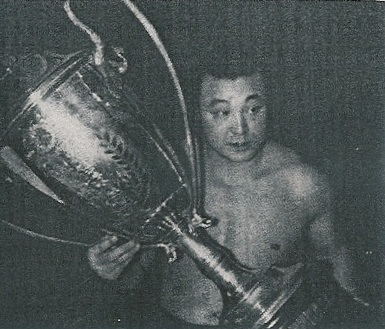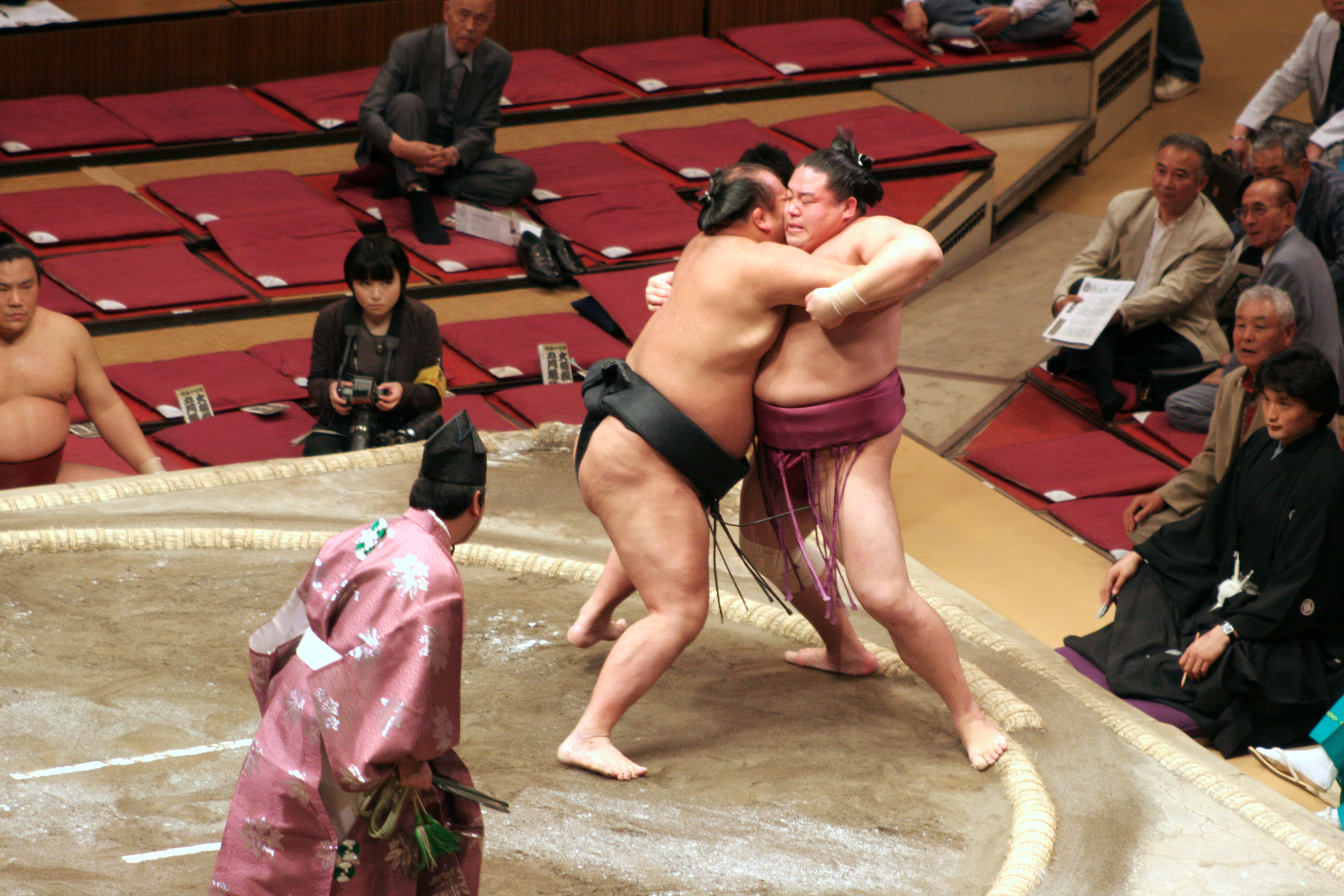|
Dewaminato
Dewaminato Rikichi (March 20, 1907, as Rikichi Satō in Tsuchizaki-Minato, Akita Prefecture, Japan – May 17, 1964), was a professional sumo wrestler with Dewanoumi stable. He made his debut in 1928, reaching the top ''makuuchi'' division in 1935. His highest rank was ''sekiwake.'' In January 1939 he won the top division ''yūshō'' or championship with an undefeated 13–0 record, ending a run of five straight championships won by Futabayama. After his retirement in 1944 he worked as a coach at his stable until 1963, when he left the sumo world. He died a year later in 1964. Career He first entered the ring in the Summer 1928 tournament. In 1932, he was one of the few unsalaried wrestlers to be expelled from sumo by the Japan Sumo Association for being involved in a strike called the "Shunjuen Incident" that was largely unsuccessful. He, along with many others, was allowed back in from the Spring 1933 tournament. He was allowed into the ''makushita'' division, but unranked ... [...More Info...] [...Related Items...] OR: [Wikipedia] [Google] [Baidu] |
List Of Sumo Tournament Second Division Champions
This is a list of wrestlers who have won the sumo second division ''jūryō'' championship since 1909, when the current championship system was established. These official tournaments are held exclusively in Japan. The wrestler who has won the most ''jūryō'' championships is Masurao, with five. Wakanami, Tagaryū, Ichinojō, Terunofuji, Asanoyama, Takerufuji and Wakatakakage are the only wrestlers to have won a ''jūryō'' championship ''after'' winning a top division or ''makuuchi'' title. The only wrestlers to win the ''jūryō'' championship but never earn promotion to the top division are Genbuyama (1927), Sagahikari (1957), Tochiizumi (1983), Hidenohana (1988), Daigaku (1991), Hakuyozan (2021) and Tochimusashi (2022). 1958 to present The first table below lists the champions since the six tournament system instituted in 1958. The championship is determined by the wrestler with the highest win–loss score after fifteen bouts, held at a rate of one per day ov ... [...More Info...] [...Related Items...] OR: [Wikipedia] [Google] [Baidu] |
Dewanoumi Stable
is a heya (sumo), stable of sumo wrestlers, part of the Dewanoumi ''Glossary of sumo terms#ichimon, ichimon'' or group of stables. It has a long, prestigious history. Its current head coach is former ''maegashira'' Oginohana Akikazu, Oginohana. As of January 2023 it had 19 wrestlers. History The stable's rise to prominence was due to the 19th ''yokozuna'' Hitachiyama, who transformed it from a minor stable when he joined sumo into a powerful recruiting house when he retired in 1914 and became its head coach. Under his leadership the stable produced three yokozuna, Ōnishiki Uichirō, Ōnishiki, Tochigiyama and Tsunenohana, ''Makuuchi#Ōzeki, ōzeki'' Kyushuzan Juro, Kyushuzan, Tsushimanada Yakichi, Tsushimanada, Ōnosato Mansuke, Ōnosato, and Hitachiiwa, and 20 other top division wrestlers. At its peak the stable contained over 200 wrestlers, and Hitachiyama's refusal to allow any of his disciples to break away and form new stables when they retired ensured its dominance remain ... [...More Info...] [...Related Items...] OR: [Wikipedia] [Google] [Baidu] |
List Of Sumo Tournament Top Division Champions
This is a list of wrestlers who have won the top division (''makuuchi'') championship in professional sumo since 1909, when the current championship system was established. These official tournaments are held exclusively in Japan. 1958 to present The first table below lists the champions since the six-tournament system was instituted in 1958. The championship is determined by the wrestler with the highest win–loss score after fifteen bouts, held at a rate of one per day over the duration of the 15-day tournament. In the event of a tie a play-off is held between the wrestlers concerned. Names in bold mark an undefeated victory (a '' zenshō-yūshō''). Names in italics mark a victory by a '' maegashira''. Figures in brackets mark the number of championships earned up to that tournament for wrestlers who won the championship more than once. ''*Hoshi would later become Hokutoumi.'' ''*Takahanada would later become the 2nd Takanohana.'' ''*Tamanoshima would later become t ... [...More Info...] [...Related Items...] OR: [Wikipedia] [Google] [Baidu] |
List Of Past Sumo Wrestlers
This is a list of prominent past wrestlers (either retired or deceased) in the sport of professional sumo. They are listed in order of the year and tournament month that they made their professional debuts. The information listed below was gleaned from the wrestlers' individual articles; refer to their links for more details. List :{, class="sortable wikitable" style="font-size: 100%" , - !Shikona, Ring name !Entered !Retired !width="80" , Highest rank !Stable !class="unsortable", Career and other notes , - , Akashi Shiganosuke , 1624? , 1643? , Yokozuna , N.A. , ''yokozuna status conferred centuries later, historical existence disputed'' , - , Ayagawa Gorōji , 1715? , 1745? , Yokozuna , N.A. , ''yokozuna status historically conferred, actual yokozuna license never proven'' , - , Maruyama Gondazaemon , 1735? , 1749-11 , Yokozuna , Nanatsumori , ''yokozuna status historically conferred, died while an active wrestler'' , - , Miyagino Nishikinosuke , 1766-10 , 1796-3 , Sekiwa ... [...More Info...] [...Related Items...] OR: [Wikipedia] [Google] [Baidu] |
Tsuchizaki-Minato
is a neighbourhood located in Akita City, Akita Prefecture, Japan. , the neighbourhood had an estimated population of 21,310 and a population density of 3,400 persons per km². The total area of the neibourhood is . Annexed by the city in 1941, it borders the neighborhoods of Shogunno on the east, Iijima on the north, Mukaihama on the west and Terauchi on the south. The Tsuchizaki area is a port town that developed at the mouth of the Omono River and a place of Port of Akita and Japan Railway Tsuchizaki factory. Tsuchizaki Float Festival is a celebration in the neighbourhood, held every year from July 20 to 21. The Tsuchizaki air raid burned the port facilities and killed more than 250 people on August 14 and 15, 1945. Schools * Tsuchizaki Elementary School * Tsuchizaki Minami Elementary School * Kohoku Elementary School * Tsuchizaki Junior High School * Akita Chuo High School Surrounding area *Port of Akita Nakajima Pier ** Nakajima Pier Ferry Terminal ** Roadside Stati ... [...More Info...] [...Related Items...] OR: [Wikipedia] [Google] [Baidu] |
List Of Sekiwake
This is a list of all sumo wrestlers whose pinnacle in the sport has been the third highest rank of '' sekiwake'' and who held the rank in the modern era of sumo since the 1927 merger of the Tokyo and Osaka organizations. There are usually two active ''sekiwake''. Wrestlers who went on to be promoted to '' ōzeki'' and ''yokozuna'' can be seen in the list of ''ōzeki'' and list of ''yokozuna''. The number of tournaments (''basho'') at ''sekiwake'' is also listed. Wrestlers who won a top division ''yūshō'' are indicated in bold. Active wrestlers (May 2025) are indicated by italics. The longest-serving ''sekiwake'' of modern times, who did not achieve further promotion, have been Hasegawa and Kotonishiki who each held the rank for 21 tournaments ( Kotomitsuki was ranked at ''sekiwake'' for 22 tournaments before being promoted to ''ōzeki''). List * Wrestler held the rank on at least two separate occasions. See also *List of active sumo wrestlers *List of past sumo wrest ... [...More Info...] [...Related Items...] OR: [Wikipedia] [Google] [Baidu] |
Haguroyama Masaji
was a Japanese professional sumo wrestler from Nakanokuchi, Niigata. He was the sport's 36th ''yokozuna''. He was a ''yokozuna'' for a period of twelve years and three months dating from his promotion to that rank in May 1941 until his retirement in September 1953, which was an all-time record until surpassed in 2019 by Hakuhō. During his career Haguroyama won seven top division championships and was runner-up on six other occasions. However, he was always in the shadow of ''yokozuna'' Futabayama, who came from the same stable. After his retirement he was the head coach of Tatsunami stable until his death in 1969. Career Haguroyama's birth name was . Haguroyama made his professional debut in January 1934 at age 19, joining Tatsunami stable. His progression was remarkably rapid. He passed through all the lower divisions in just one tournament each, in every case winning the divisional championship – a feat unlikely ever to be equalled. He made his debut in the top ''makuu ... [...More Info...] [...Related Items...] OR: [Wikipedia] [Google] [Baidu] |
Sumo People From Akita Prefecture
is a form of competitive full-contact wrestling where a ''rikishi'' (wrestler) attempts to force his opponent out of a circular ring (''dohyō'') or into touching the ground with any body part other than the soles of his feet (usually by throwing, shoving or pushing him down). Sumo originated in Japan, the only country where it is practised professionally and where it is considered the national sport. It is considered a ''gendai budō'', which refers to modern Japanese martial arts, but the sport has a history spanning many centuries. Many ancient traditions have been preserved in sumo, and even today the sport includes many ritual elements, such as the use of salt purification, from Shinto. Life as a wrestler is highly regimented, with rules regulated by the Japan Sumo Association. Most sumo wrestlers are required to live in communal sumo training stables, known in Japanese as '' heya'', where all aspects of their daily livesfrom meals to their manner of dressare dictated ... [...More Info...] [...Related Items...] OR: [Wikipedia] [Google] [Baidu] |
Japanese Sumo Wrestlers
Japanese may refer to: * Something from or related to Japan, an island country in East Asia * Japanese language, spoken mainly in Japan * Japanese people, the ethnic group that identifies with Japan through ancestry or culture ** Japanese diaspora, Japanese emigrants and their descendants around the world * Japanese citizens, nationals of Japan under Japanese nationality law ** Foreign-born Japanese, naturalized citizens of Japan * Japanese writing system, consisting of kanji and kana * Japanese cuisine, the food and food culture of Japan See also * List of Japanese people * * Japonica (other) * Japanese studies , sometimes known as Japanology in Europe, is a sub-field of area studies or East Asian studies involved in social sciences and humanities research on Japan. It incorporates fields such as the study of Japanese language, history, culture, litera ... {{disambiguation Language and nationality disambiguation pages ... [...More Info...] [...Related Items...] OR: [Wikipedia] [Google] [Baidu] |
Glossary Of Sumo Terms
The following words are terms used in sumo wrestling in Japan. A B C D E F G H I J K M N O R S T W Y Z References External links Glossary of Sumo TermsSumopediaat NHK World-Japan {{Glossaries of ... [...More Info...] [...Related Items...] OR: [Wikipedia] [Google] [Baidu] |
Kimarite
is the technique used in sumo by a (wrestler) to win a match. It is officially decided or announced by the (referee) at the end of the match, though judge (sumo), judges can modify this decision. The records of are then kept for statistical purposes. The Japan Sumo Association (JSA) have officially recognized 82 such techniques since 2001, with five also recognized as winning non-techniques. However, only about a dozen of these are frequently and regularly used by . A sumo match can still be won even without a , by the virtue of disqualification due to a (foul), such as striking with closed fist. Basic techniques The are some of the most common winning techniques in sumo, with the exception of . is a rarely used basic that pushes down the opponent into the ground back-first by leaning forward while grappling. is a basic that requires pushing the opponent out of the ring using the arms, without holding their (belt) or extending the arms. is simila ... [...More Info...] [...Related Items...] OR: [Wikipedia] [Google] [Baidu] |



